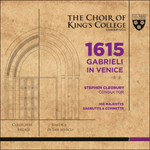Processions, both round the Piazza San Marco, and to churches elsewhere in Venice often included the singing of litanies like that of the Litany of the Blessed Virgin, in which a series of petitions to the Father, Son and Holy Ghost, and to the Virgin in all her guises to ‘pray for us’ is framed by an initial Kyrie and a concluding Agnus Dei. The music used in processional litanies would have been of the simplest kind only—usually plainsong. A complex setting like Gabrieli’s for eight voices, might have been used for devotional purposes by a confraternity, or it may have been linked with the annual celebration of the victory over the Turks at the Battle of Lepanto (1571), a moment of the greatest significance in Venetian history and a victory that was attributed by Pope Pius V to the intervention of the Madonna of the Rosary; in Venice it was celebrated by the doge and choir of St Mark’s at the church of Santa Giustina.
from notes by John Whenham © 2012
Les processions autour de la place Saint-Marc et dans les autres églises de Venise s’accompagnaient souvent de litanies chantées comme la Litanie de la Sainte Vierge, qui se compose d’une série de supplications, «Priez pour nous», adressées au Père, au Fils et au Saint-Esprit, et à la Vierge sous toutes ses formes, encadrées par un Kyrie initial et un Agnus Dei final. La musique des litanies processionnelles se limitait au genre le plus simple—généralement le plain-chant. Une musique complexe comme celle à huit voix de Gabrieli a peut-être été utilisée à des fins pieuses par une confrérie; il est également possible qu’elle ait été liée à la célébration annuelle de la victoire sur les Turcs à la Bataille de Lépante (1571), moment de la plus haute importance dans l’histoire de Venise et victoire attribuée par le pape Pie V à l’intervention de la Madone du Rosaire; à Venise, elle était célébrée par le doge et le chœur de Saint-Marc à l’église Santa Giustina.
extrait des notes rédigées par John Whenham © 2012
Français: Marie-Stella Pâris
Bei Prozessionen, sowohl um die Piazza San Marco herum als auch zu Kirchen, die sich anderswo in Venedig befanden, wurden oft Litaneien gesungen, wie etwa die Lauretanische Litanei, in der eine Reihe von Anrufungen an den Vater, Sohn und Heiligen Geist sowie die Jungfrau in all ihren Erscheinungen, „für uns zu bitten“ von einem eröffnenden Kyrie und einem abschließenden Agnus Dei umrahmt sind. Die Musik in solchen Prozessions-Litaneien war stets sehr schlicht—zumeist Cantus planus. Eine komplexe Vertonung wie Gabrielis Version für acht Stimmen entstand möglicherweise zum Gebrauch in der Andacht einer Bruderschaft, oder sie könnte auch der alljährlichen Feier des Sieges über die Türken bei der Seeschlacht von Lepanto (1571) gewidmet gewesen sein, da es sich dabei um eine höchst bedeutsame Wendung in der Geschichte Venedigs handelte und um einen Sieg, den Papst Pius V. dem Einschreiten der Rosenkranzmadonna zuschrieb. In Venedig wurde er von dem Dogen und dem Chor von San Marco in der Kirche Santa Giustina gefeiert.
aus dem Begleittext von John Whenham © 2012
Deutsch: Viola Scheffel


 Gabrieli (G): 1615 - Gabrieli in Venice
Gabrieli (G): 1615 - Gabrieli in Venice
